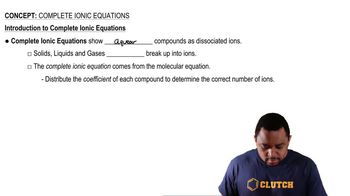An automotive fuel injector dispenses a fine spray of gasoline into the automobile cylinder, as shown in the bottom drawing here. When an injector gets clogged, as shown in the top drawing, the spray is not as fine or even and the performance of the car declines. How is this observation related to chemical kinetics? [Section 14.1]
Suppose that for the reaction K + L → M, you monitor the production of M over time, and then plot the following graph from your data:

(b) Is the reaction completed at t = 15 min? [Section 14.2]
 Verified step by step guidance
Verified step by step guidance
Verified Solution
Key Concepts
Reaction Completion

Rate of Reaction

Equilibrium

Consider the following graph of the concentration of a substance X over time. Is each of the following statements true or false? (d) As time progresses, the curve will eventually turn downward toward the x-axis. [Section 14.2]
You study the rate of a reaction, measuring both the concentration of the reactant and the concentration of the product as a function of time, and obtain the following results:
Which chemical equation is consistent with these data: (i) A → B, (ii) B → A, (iii) A → 2 B, (iv) B → 2 A?
The following diagrams represent mixtures of NO(g) and O21g2. These two substances react as follows: 2 NO1g2 + O21g2¡2 NO21g2 It has been determined experimentally that the rate is second order in NO and first order in O2. Based on this fact, which of the following mixtures will have the fastest initial rate? [Section 14.3]
Given the following diagrams at t = 0 min and t = 30 min
After four half-life periods for a first-order reaction, what fraction of reactant remains? [Section 14.4]
Which of the following linear plots do you expect for a reaction A¡products if the kinetics are (a) zero order, [Section 14.4]
